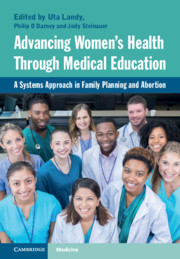 Advancing Women's Health Through Medical Education
Advancing Women's Health Through Medical Education Book contents
- Advancing Women’s Health Through Medical Education
- Reviews
- Advancing Women’s Health Through Medical Education
- Copyright page
- Dedication
- Contents
- Contributors
- Preface
- Acknowledgments
- Introduction
- Section I Abortion Training: Workforce, Leadership, Social & Political Impact
- Section II Integration of Abortion into Graduate Medical Education
- Section III Family Planning Curricular Design & Implementation
- Section IV Reproductive Health Services & Abortion Training: Global Examples
- Chapter 26 Sexual and Reproductive Health (SRH) Workforce
- Chapter 27 Medical Education for Safe Abortion Services in Nepal
- Chapter 28 Abortion Training and Integration in Ghana
- Chapter 29 Pre-service Integration of Abortion and Contraception Trainings in Ethiopia
- Chapter 30 Abortion Training and Integration into Clinical Practice in Colombia
- Chapter 31 Medical Education in Sexual and Reproductive Health in Uruguay
- Chapter 32 Abortion Training and Integration of Legal Services in the Public Health System of Mexico City
- Chapter 33 Abortion Training Models in Sweden
- Chapter 34 Abortion Training and Integration in the United Kingdom
- Chapter 35 Abortion Training and Integration in Ireland
- Index
- References
Chapter 29 - Pre-service Integration of Abortion and Contraception Trainings in Ethiopia
from Section IV - Reproductive Health Services & Abortion Training: Global Examples
Published online by Cambridge University Press: 30 July 2021
- Advancing Women’s Health Through Medical Education
- Reviews
- Advancing Women’s Health Through Medical Education
- Copyright page
- Dedication
- Contents
- Contributors
- Preface
- Acknowledgments
- Introduction
- Section I Abortion Training: Workforce, Leadership, Social & Political Impact
- Section II Integration of Abortion into Graduate Medical Education
- Section III Family Planning Curricular Design & Implementation
- Section IV Reproductive Health Services & Abortion Training: Global Examples
- Chapter 26 Sexual and Reproductive Health (SRH) Workforce
- Chapter 27 Medical Education for Safe Abortion Services in Nepal
- Chapter 28 Abortion Training and Integration in Ghana
- Chapter 29 Pre-service Integration of Abortion and Contraception Trainings in Ethiopia
- Chapter 30 Abortion Training and Integration into Clinical Practice in Colombia
- Chapter 31 Medical Education in Sexual and Reproductive Health in Uruguay
- Chapter 32 Abortion Training and Integration of Legal Services in the Public Health System of Mexico City
- Chapter 33 Abortion Training Models in Sweden
- Chapter 34 Abortion Training and Integration in the United Kingdom
- Chapter 35 Abortion Training and Integration in Ireland
- Index
- References
Summary
In Ethiopia, graduates of the health profession lack the competencies required to provide reproductive health services before they entering practice. Since 2015 the Center for International Reproductive Health Training (CIRHT) supported ten higher teaching institutions to implement a new model that assures acquisition of competencies for reproductive health services focused on comprehensive abortion (CAC) and contraceptive care (CC) in pre-service (medical student and residency) education settings. A direct link with the departments of Gynecology and Obstetrics (GYNOBS) and schools of midwifery was established. The program included all levels of providers but targeted medical students, interns, residents and midwives. The multipronged approach of CIRHT focused on: 1) faculty development: ensuring up-to-date clinical knowledge and skills to teach and assess clinical andresearch skills; 2) establishing clinical simulation labs and comprehensive Sexual and Reproductive Health(SRH) (Michu)clinics 3) empowering students to become self-learners through the Peer Assisted Learning (PAL) program and engage in collaborative learning 4) strengthening systems support: work with the Ministry of Health(MOH), Ministry of education(MOE) and Professional societies in designingcompetency based curricula.
Keywords
- Type
- Chapter
- Information
- Advancing Women's Health Through Medical EducationA Systems Approach in Family Planning and Abortion, pp. 290 - 300Publisher: Cambridge University PressPrint publication year: 2021
